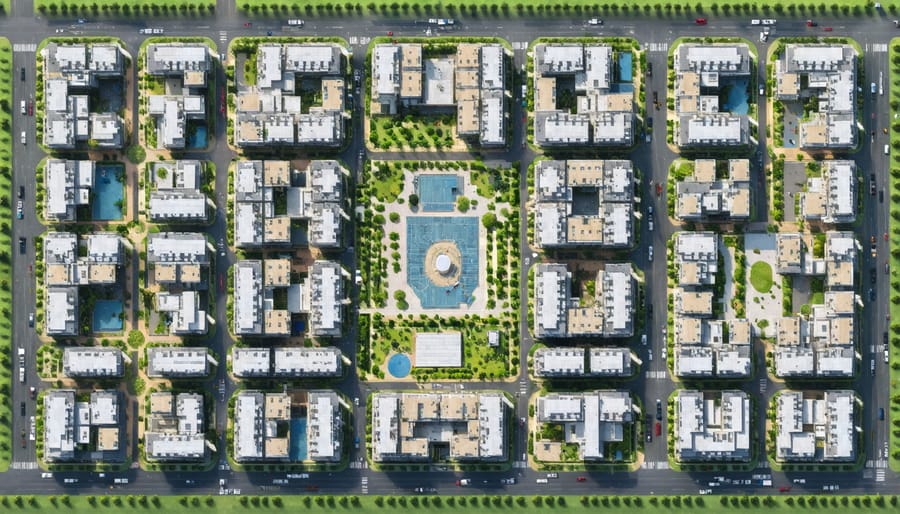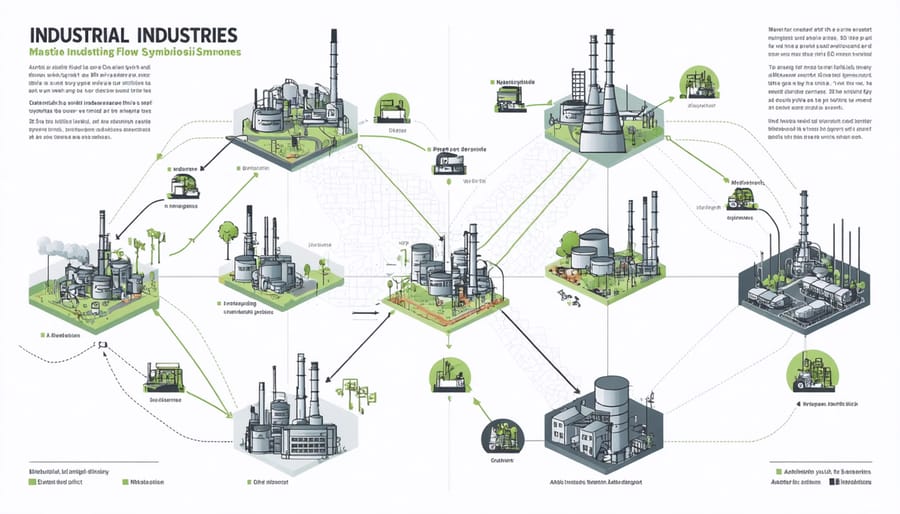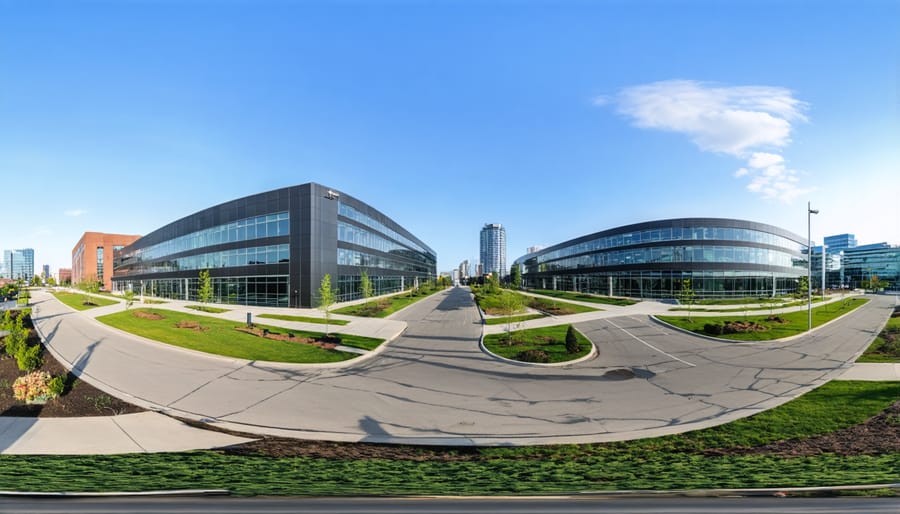Zoning regulations shape the very fabric of our cities, determining not just where we live and work, but how sustainable and circular our urban economies can become. In Canada’s rapidly evolving municipalities, strategic zoning serves as a powerful tool for transforming traditional linear development patterns into circular economy hubs. From Vancouver’s eco-industrial zones to Toronto’s mixed-use developments, forward-thinking zoning policies are enabling businesses to collaborate, share resources, and minimize waste while maximizing economic opportunities.
Modern urban planners increasingly recognize zoning’s crucial role in fostering sustainable business ecosystems. By designating areas for complementary industries, creating innovation districts, and allowing flexible land use, cities can naturally cultivate circular economy networks. These thoughtfully planned zones reduce transportation costs, facilitate material reuse between businesses, and create vibrant, resilient commercial communities.
For Canadian businesses and municipalities, understanding and leveraging zoning regulations has become essential for competitive advantage in the green economy. Strategic zoning decisions today will determine our cities’ ability to support circular business models, reduce environmental impact, and maintain economic prosperity for decades to come.
Reimagining Traditional Zoning for Circular Cities
Mixed-Use Development Zones
Mixed-use development zones represent a progressive approach to urban planning that combines residential, commercial, and community spaces within close proximity. This integration creates vibrant, walkable neighborhoods where people can live, work, and socialize without relying heavily on vehicle transportation.
In Canadian cities like Vancouver’s Yaletown and Toronto’s Distillery District, mixed-use developments have demonstrated remarkable success in resource efficiency. These areas typically feature retail spaces at street level, offices on middle floors, and residential units above, maximizing land use while reducing infrastructure costs.
According to the Canada Green Building Council, mixed-use developments can reduce energy consumption by up to 30% compared to single-use zones. This efficiency stems from shared heating systems, reduced transportation needs, and optimized utility infrastructure.
These zones also strengthen community resilience by creating diverse economic opportunities and social connections. The proximity of various services and amenities supports local businesses while reducing carbon emissions from transportation. During the COVID-19 pandemic, mixed-use neighborhoods proved particularly resilient, as residents could access essential services within walking distance.
For developers and investors, mixed-use zones often provide higher returns on investment while contributing to sustainable urban development goals.

Industrial Symbiosis Districts
Industrial symbiosis districts represent an innovative approach to sustainable urban development, where businesses collaborate to maximize resource efficiency and minimize waste. These specialized zones enable companies to create closed-loop systems, turning one facility’s waste into another’s raw materials. As Canadian cities embrace green technology innovations, these districts are becoming increasingly vital to urban sustainability.
The Burnside Industrial Park in Halifax serves as a prime example, where over 1,300 businesses participate in resource sharing networks. Companies exchange materials, water, and energy, reducing operational costs while minimizing environmental impact. Similar initiatives are emerging in Vancouver’s False Creek Flats, where city planners have designated areas specifically for circular economy businesses.
To establish successful industrial symbiosis districts, municipalities typically require participating businesses to meet specific criteria for waste management and resource sharing. These zones often feature shared infrastructure, such as waste processing facilities and energy recovery systems, making it easier for businesses to integrate sustainable practices into their operations.

Innovative Canadian Zoning Solutions
Case Study: Toronto’s Circular Business Parks
Toronto’s Pearson Eco-Business Zone showcases how strategic zoning can foster sustainable industrial development. Spanning 12,000 hectares near Pearson International Airport, this innovative district has become a model for circular waste management initiatives and resource-efficient manufacturing.
The zone’s success stems from its flexible zoning bylaws that encourage business collaboration. Companies within the park share resources, infrastructure, and waste streams, creating a closed-loop system that reduces environmental impact while boosting operational efficiency. For instance, one manufacturer’s waste heat provides energy for neighboring facilities, while organic waste from food processors supplies local biogas production.
Partners in Project Green, the organization overseeing the zone, reports that participating businesses have achieved an average 20% reduction in operating costs through resource sharing and improved waste management. The district has attracted over 12,000 businesses, creating a thriving ecosystem of sustainable enterprise.
Key features of the zone’s regulatory framework include:
– Permitted mixed-use development for complementary industries
– Incentives for implementing sustainable technologies
– Streamlined approval processes for circular economy initiatives
– Support for shared infrastructure development
The success of Toronto’s eco-business zone has inspired similar developments across Canada, demonstrating how thoughtful zoning can drive both environmental sustainability and economic growth.

Vancouver’s Eco-Industrial Zones
Vancouver has emerged as a leader in eco-industrial zoning, implementing innovative strategies that combine environmental sustainability with economic growth. The city’s approach focuses on creating designated zones where businesses can collaborate to reduce waste, share resources, and minimize their environmental impact while maintaining profitable operations.
The False Creek Flats area serves as a prime example of Vancouver’s eco-industrial vision. This 450-hectare district has been transformed from traditional industrial land into a thriving hub for green businesses and circular economy initiatives. The zone encourages companies to implement shared waste management systems, renewable energy solutions, and resource recovery programs.
Notable features of Vancouver’s eco-industrial zones include requirements for green building standards, infrastructure for waste-to-resource conversion, and incentives for businesses that adopt sustainable practices. Companies within these zones often participate in industrial symbiosis, where one company’s waste becomes another’s raw material.
According to the Vancouver Economic Commission, businesses in these eco-industrial zones have reported average operational cost savings of 20% through resource sharing and improved efficiency. The success has inspired other Canadian municipalities to develop similar zoning strategies.
The city continues to expand its eco-industrial framework through policy innovations like the Zero Waste 2040 strategy, which integrates circular economy principles into zoning requirements. This approach has positioned Vancouver as a model for sustainable industrial development while maintaining strong economic growth.
Implementation Strategies for Businesses
Identifying Optimal Locations
Selecting optimal locations for circular business models requires careful analysis of existing zoning regulations and community needs. Start by identifying areas with mixed-use zoning designations, which typically offer greater flexibility for innovative business operations. These zones often allow for multiple activities within the same space, supporting the efficient use of resources and promoting sustainable investment opportunities.
Look for locations near complementary businesses that can participate in resource sharing or waste-to-resource programs. Industrial parks and innovation districts often provide ideal settings for circular operations, offering existing infrastructure and potential collaboration partners. Consider proximity to transportation hubs and major arterial roads to facilitate efficient material movement and reduce transportation costs.
Access to utilities, particularly renewable energy sources and water recycling facilities, should factor into location decisions. Areas with progressive municipal policies supporting green initiatives often provide additional incentives and operational advantages. Consulting local economic development offices can reveal designated zones that align with circular economy principles and may offer tax benefits or development grants.
Navigating Zoning Requirements
Successfully navigating zoning requirements for circular economy initiatives requires a strategic approach and thorough understanding of local regulations. Many Canadian municipalities now offer streamlined processes for businesses implementing eco-innovation business models, particularly in mixed-use and industrial zones.
Start by consulting your local planning department early in the development process. Most municipalities provide pre-application meetings where you can discuss your circular economy project and receive guidance on zoning compliance. Keep detailed documentation of your sustainable practices and how they align with existing zoning bylaws.
Consider forming partnerships with neighboring businesses to create industrial symbiosis opportunities within permitted zones. Many Canadian cities now encourage these collaborative arrangements through special zoning provisions and expedited permit processes.
Key steps include:
– Reviewing current zoning classifications and permitted uses
– Identifying specific circular economy activities planned for your site
– Understanding waste management and material storage requirements
– Confirming building modification allowances
– Checking for special sustainability incentives or overlay zones
Remember that zoning officials increasingly recognize the value of circular economy initiatives and may be willing to work with you to find compliant solutions.
Circular economy zoning in Canada shows tremendous promise for creating more sustainable, resilient communities while fostering economic growth. The integration of circular principles into urban planning has already demonstrated significant benefits, including reduced waste management costs, increased property values, and improved quality of life for residents.
Canadian municipalities leading this transformation have reported up to 30% reduction in landfill waste and a 25% increase in local business collaboration through industrial symbiosis networks. Cities like Vancouver and Toronto are setting examples with their innovative approaches to mixed-use developments and eco-industrial parks.
Looking ahead, experts predict that circular economy zoning will become increasingly important as Canada moves toward its 2050 net-zero emissions target. The Federation of Canadian Municipalities estimates that municipalities implementing circular zoning strategies could create up to 100,000 new green jobs by 2030 while generating billions in economic opportunities.
For business owners and investors, this evolution in urban planning presents significant opportunities. As more cities adopt circular economy principles, properties in well-planned zones are expected to appreciate in value and attract environmentally conscious tenants and customers.
The success of circular economy zoning ultimately depends on continued collaboration between government officials, business leaders, and community stakeholders. With proper implementation and support, these innovative zoning approaches will help shape a more sustainable and prosperous future for Canadian cities and businesses alike.
